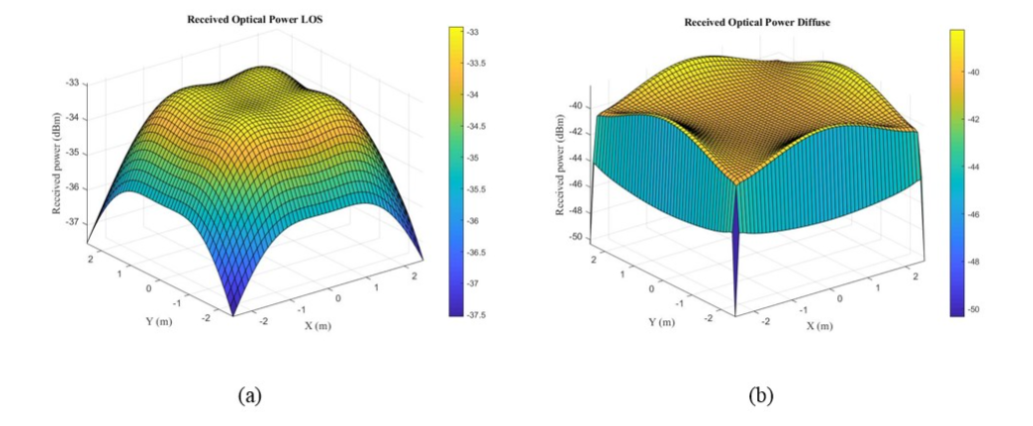Iterative receiver design for indoor wireless visible light communication system
Main Article Content
Abstract
White LED will be a dominant device for lighting in the near future through which we can have the luminance and data transmission simultaneously. An indoor wireless visible light communication system (IWVLC) describes the communication during the indoor applications. This paper presents an iterative receiver design for the IWVLC system and proposes the Soft-Output-Viterbi algorithm to equalize and detect the signal at the receiver of the IWVLC system which is based on the numerical simulation. The performance of the proposed algorithm is better than the conventional Viterbi algorithm in terms of the bit error rate. The simulation results unveil the performance of the proposed iterative algorithm where it can be seen that the BER comes out to be less at the same SNR (dB) as compared to the conventional ones even when the data rate is very high.
Article Details
References
K. Toshihiko, N. Masao, Fundamental analysis for visible light communication system using LED Lights, IEEE Transaction on Consumer Electronics 50 (2004) 100 – 107.
Z. Lubin, B. Dominic, M. Hoa Le, L. Kyungwoo, J. Daekwang,O. Yunje, Improvement of date rate by using equalization in an indoor visible light communication system, IEEE Interna-tional Conference on Circuits and Systems for Communications, 2008, pp. 678 – 682.
H. Q. Nguyen, J. H. Choi, M. Kang, Z. Ghassemlooy, D. H.Kim, S. K. Lim, T. G. Kang, C. G. Lee, A Matlab-based simulation program for indoor visible light communication system,The 7th International Symposium on Communication Systems,Networks & Digital Signal Processing (CSNDSP 2010), 2010,pp. 537 – 541.
L. Kwonhyung, P. Hyuncheol, R. B. John, Indoor channel char-acteristics for visible light communications, IEEE Communications Letter 15 (2011) 217 – 219.
C. Yan, Y. Xu, J. Shen, J. Chen, A combination of VLC andWiFi based indoor wireless access network and its hand over strategy, 2016 IEEE International Conference on UbiquitousWireless Broadband (ICUWB), 2016.
L. Feng, H. Yang, R. Q. Hu, J. Wang, MmWave and VLC-based indoor channel models in 5G wireless networks, IEEE WirelessCommunications (2018) 70–77.
K. Adisorn, S. Jesada, K. Piya, Partial-response maximum-likelihood technique for indoor wireless visible light communication system, Journal of Thai Interdisciplinary Research 11(2016) 22 – 28.
R. Gallager, Low-density parity-check codes, IRE Transactions on information theory IT-8 (1962) 21 – 28.
C. Yishuo, S. Yanyong, X. Dong, D. Chao, Research on performance of visible light communication based on LDPC code,2015 Fifth International Conference on Instrumentation and Measurement, Computer, Communication and Control (IMCCC), 2015, pp. 1461 – 1465.
X. Lu, J. L. Tiffany, New miller codes for run-length control invisible light communications, IEEE Transactions on WirelessCommunications 17 (2018) 1798 – 1810.
J. Moon, W. Zeng, Equalization for maximum likelihood detector, IEEE Transactions Magazine 31 (1995) 1083 – 1088.
D. C. Roy, D. Francois, H. Reto, H. Walter, S. Wolfgang, APRML system for digital magnetic recording, IEEE Journal on Selected Areas in Communications 10 (1992) 38 – 56.
O. Dominic, L. M. Hoa, Z. Lubin, F. Grahame, L. Kyung-woo, J. Daekwang, O. YunJe, T. W. Eun, Indoor visible light communications: challenges and prospects, Free-Space Laser Communications. VIII, Proceeding of The International Society for Optical Engineering, 2008, pp.709106-1 – 709106-9.
P. Kovintaveewat. Signal Processing for Digital Data Storage(Volume II): Receiver Design, National Electronics and Computer Technology Center, 2007.
M. Jaekyun, Z. Weining, Equalization for maximum likelihood detector, IEEE Transactions on Magnetics 31 (2002) 2340– 2342.
P. Kovintaveewat. Signal Processing for Digital Data Storage(Volume III): Advance Receiver Design, National Electronics and Computer Technology Center, 2011.
E. C. Strinati, S. Barbarossa, J. L. Gonzalez-Jimenez, D.K ́tenas, N. Cassiau, L. Maret, ́C. Dehos, 6G: The Next Frontier, (2019) 1–16.
H. Haas, LiFi is a paradigm-shifting 5G technology, Reviews in Physics 3 (2018) 26–31.


